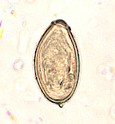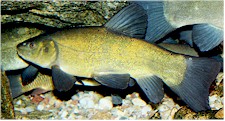Opisthorchis felineus, the cat liver fluke, is a parasitic flatworm belonging to the trematodes that has cats, occasionally dogs, other carnivores that feed on freshwater fish (e.g. foxes, otters, etc.) and also humans as final hosts.
It infests several freshwater fishes as well, which act as intermediate hosts (see life cycle below).

It is found worldwide, both in tropical and cold regions, around freshwaters such as lakes, rivers, etc. Well known endemic regions are Russia, Siberia and several countries in Eastern Europe, where it is estimated that more than 1 million people are affected. Incidence in Western Europe (especially Italy) seems to be increasing.
Opisthorchis viverrini is a related species found in tropical regions in Asia that is also important as a human disease.
The disease caused by this parasite is called opisthorchiasis.
Opisthorchis felineus does not affect herbivores (cattle, sheep, goats, horses, etc.), pig or poultry.
Are animals infected with Opisthorchis felineus flukes contagious for humans?
- Pets. NO. If pets are infected with Opisthorchis flukes, they are not contagious for humans, neither through contact, nor through the feces (it is assumed that they are not eaten by humans...).
- Fish: YES if consumed uncooked.
You can find additional information in this site on the general biology of parasitic worms and/or flukes.
Final location of Opisthorchis felineus
Predilection sites of Opisthorchis felineus flukes are the hepatic, biliary and pancreatic ducts.
Anatomy of Opisthorchis felineus

Adult cat flukes have the oval shape and flattened body characteristic for most flukes. They reach up to 1.5 cm in length and 0.7 cm in width. They have a light brownish-to pink color. The cuticle has no spines. They have 2 prominent suckers, an oral sucker and a ventral one. As other flukes they have no external signs of segmentation.
The mouth ends in the pharynx, a muscular tube that allows sucking. The digestive system is blind (i.e. without exit: the only opening is the mouth) and not linear, as in most animals, but branched, ending in several blind ducts (called coeca).
As most flukes, lancet flukes are simultaneous hermaphrodites, i.e. they have both male and female reproductive organs.
The eggs have an oval shape and are quite small (~30x18 micrometers), brownish, operculated and embryonated.
Life cycle and biology of Opisthorchis felineus

Opisthorchis felineus has an indirect life cycle with two intermediate hosts: freshwater snails of the genus Bithynia as the first intermediate host, and several freshwater fish species as second intermediate hosts, mostly carps and other cyprinids. So far about 20 different cyprinid species have been identified as intermediate hosts of cat liver flukes.
Eggs shed out with the feces of final hosts reach the water and fall to the bottom and the snails eat them. Inside the snails the miracidia hatch and develop further to sporocysts and multiply asexually to cercariae. Cercariae leave the snail and swim until they are eaten by a suitable fish, where they encyst to metacercariae (in muscles, skin, fins, etc.).
When a final host (cats, foxes, humans, etc.) eats the contaminated fish, the metacercariae are released in the stomach and the young flukes migrate through the common bile duct (ductus choledocus) to the biliary and hepatic ducts where the mature and start laying eggs. The prepatent period in cats lasts 2 to 4 weeks.
Harm caused by Opisthorchis felineus, symptoms and diagnosis
In cats and dogs, most Opisthorchis felineus infections cause no clinical signs are rather benign. In case of rare massive infection (more than 100 flukes) thickening and even obstruction of the bile ducts has been reported, as well as enteritis, diarrhea, biliary stones and damage to liver and pancreas.
Diagnosis is confirmed through eggs detected in fecal samples. However, egg shedding is intermittent, i.e. false negatives are possible.
Prevention and control of Opisthorchis felineus infections
In endemic regions, the key measure to avoid infection of cats and dogs is to keep them away from eating raw fish and feeding them with well-cooked fish: pickling and freezing is not enough to kill the metacercariae.
Chemical control of Opisthorchis felineus flukes is very unusual, and in most countries there are no pet or livestock anthelmintics with a claim against Opisthorchis felineus flukes. Praziquantel has been used successfully against human opisthorchiasis and it should work in pets as well.
Chemical control of the snails with molluscicides (i.e. snail killers) such as copper sulphate, sodium pentachlorophenate, niclosamide, etc. is never an option for controlling cat liver flukes in the environment. It would never be economic and is anyway hopeless and useless, because it is virtually impossible to treat every place where they can survive, and they reproduce extremely quickly. In addition, the use of such molluscicides is not approved in most countries.
There are so far no vaccines against Opisthorchis felineus flukes. To learn more about vaccines against parasites of livestock and pets click here.
Biological control of Opisthorchis felineus flukes (i.e. using their natural enemies) is so far not feasible.
You may be interested in an article in this site on medicinal plants against external and internal parasites.
|
Ask your veterinary doctor! If available, follow more specific national or regional recommendations for Opisthorchis felineus control. |
Resistance of Opisthorchis felineus to anthelmintics
So far there are no reports on resistance of Opisthorchis felineus flukes to anthelmintics.
This means that if an anthelmintic fails to achieve the expected efficacy, chance is very high that it not due to resistance. Either the product was used incorrectly, or the product was unsuited for the control of Opisthorchis felineus. Incorrect use is the most frequent reason for failure of antiparasitic drugs.